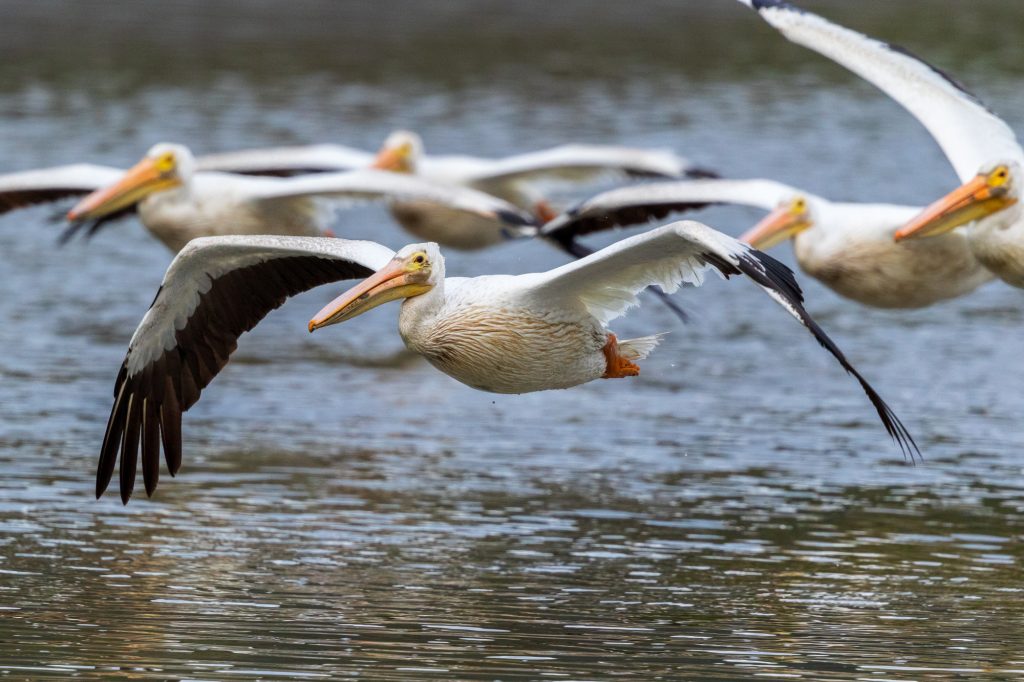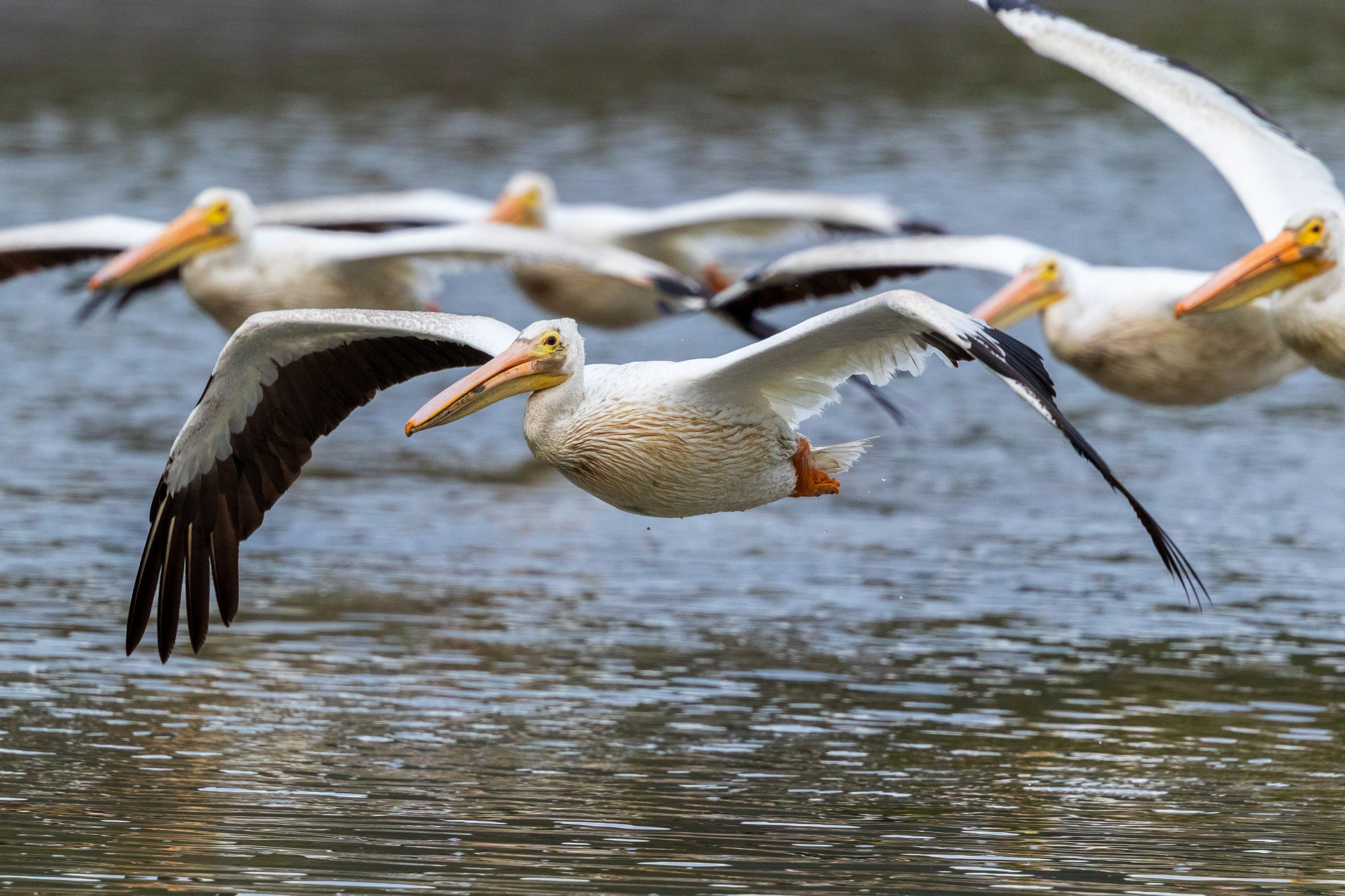In Oregon, you can spot both species of Pelican native to North America. These magnificent creatures are known as the American White Pelican and the Brown Pelican, and their presence is most notable during the summer season.
Pelicans, being among the largest birds on Earth, possess distinct features that make them easily recognizable. With their gigantic bills, expandable throat pouches, and sturdy feet, they command attention. Despite their impressive size, they are surprisingly light due to the air pockets within their skeleton and skin, aiding them in buoyancy. Their elongated wings assist in effortless gliding through the skies.
The world hosts a total of eight pelican species, two of which inhabit North America—the American White Pelican and the Brown Pelican.
During the breeding period, pelicans undergo remarkable transformations. Their facial skin, as well as their throats and bills, take on vivid hues, and some even develop additional appendages on their bills.
Pelicans exhibit communal breeding habits, forming colonies with up to 50,000 individuals. Depending on the species, these colonies may choose to nest either on the ground or in trees. After approximately 25 days in the nest, the young ones congregate in “creches” comprising as many as 100 juveniles. Remarkably, the parents possess the ability to recognize and exclusively feed their own offspring.
While pelicans prey on various creatures, they are not classified as birds of prey, as that designation is reserved for raptors. Their diet primarily consists of fish, although they also indulge in crabs, frogs, snakes, mammals, birds, and insects.
The remarkable throat pouch of pelicans aids in catching fish, allowing them to drain the water before swallowing their catch. Juvenile pelicans even feed directly from their parents’ throat pouches.
To aid in identifying the Pelican species found in Oregon, this guide utilizes information sourced from avibase and data collected by dedicated bird watchers on ebird. It provides accurate details about the specific periods when these avian species can be observed.
2 Pelican Species in Oregon:
American White Pelican

During the period spanning from April to October, American White Pelicans are more frequently sighted in Oregon, with some individuals choosing to remain year-round. These birds account for approximately 3% of the checklists submitted by bird watchers during the summer season.
With their impressive wingspan, American White Pelicans rank among the largest birds in North America. These majestic creatures predominantly exhibit a white plumage, but when in flight or with their wings spread, black flight feathers become visible. Their eyes possess a bluish-gray hue, while their facial skin surrounding the eyes showcases a yellow tone. Pale orange bills, pouches, and feet complete their distinctive appearance. Juveniles, on the other hand, display light gray feathers with darker brown napes.
Breeding adults of the American White Pelican possess distinct coloration compared to non-breeding individuals. They develop a yellow plate on their upper bills, resembling a horn. While their bodies retain their all-white appearance, their eyes, bills, legs, and feet become vividly orange.
The American White Pelican experiences several molting changes referred to as “eclipse.” During spring, a noticeable yellowish patch appears on their breast and chest, while blackish feathers emerge on their heads during the summer months.
- Pelecanus erythrorhynchos
- Length: 60 – 63 inches (152 – 160 cm)
- Weight: 246.4 ounces (6983 g)
- Wingspan: 96 – 110 inches (244 – 279 cm)
American White Pelicans breed in secluded inland lakes within North America and migrate to spend their winters along the southern Pacific Coast of the United States, the Gulf of Mexico, Mexico, and Central America. During migration, these pelicans can be observed in various states across the western and central regions of the United States.
Their preferred habitats include shallow freshwater lakes, wetlands, and the fringes of lakes and rivers. In winter, they can be found in coastal bays, inlets, and estuaries, where they forage in shallow waters and rest on sandbars.
American White Pelicans predominantly feed on fish, skillfully swimming on the water’s surface and capturing their prey with their expansive bills. They also engage in cooperative foraging, coordinating efforts with other birds to drive fish towards the shore, enabling efficient scooping.
Moreover, these opportunistic creatures venture far and wide in search of more bountiful feeding grounds. They occasionally consume crayfish, amphibians, and salamanders, and are known to snatch fish from the water’s surface, pilfering from other birds.
As for vocalizations, American White Pelicans are typically silent, emitting only occasional grunts. However, their young can be quite noisy, clamoring for food in their large colonies.
Nests of American White Pelicans consist of simple, shallow depressions on the ground, adorned with twigs, sticks, reeds, and other materials for added protection. The female lays one to two eggs, which both parents diligently incubate for up to thirty-six days. Sadly, due to siblicide—a phenomenon where one sibling kills the other—only one chick per nest usually survives.
Fun Facts: The impressive bill of an American White Pelican can hold up to three gallons of water. When fishing, it tilts its bill downward to drain the water, allowing it to swallow the remaining fish within its throat sac.
Brown Pelican

Brown Pelicans are predominantly spotted along the Oregon coast from mid-April to November, accounting for approximately 1% of the summer checklists. However, a few individuals remain in the area throughout the year.
Non-breeding adult Brown Pelicans exhibit white heads and necks, complemented by pale yellow foreheads. Their long, pale bills display a combination of yellow and orange hues. Grayish-brown bodies, short black legs, and webbed feet complete their appearance. Juveniles showcase brown heads, necks, backs, and wings, with bluish-gray bills and light brown underparts.
The Brown Pelican encompasses five subspecies, two of which breed within the United States. P.o.californicus represents the Pacific Coast variant, while P.o.carolinensis denotes the Atlantic Coast variant.
Distinguishing between Pacific and Atlantic Brown Pelicans becomes more evident during the breeding season. Both species exhibit white heads with brighter yellow foreheads, while the color of their napes transitions from white to dark brown. Atlantic Brown Pelicans possess olive-brown throat pouches, while their Pacific counterparts feature red skin in that area.
- Pelecanus occidentalis
- Length: 48 – 50 inches (122 – 127 cm)
- Weight: 131.2 ounces (3718 g)
- Wingspan: 78 – 84 inches (198 – 213 cm)
Brown Pelicans either breed, migrate, or remain resident year-round along the Pacific and Atlantic Coasts of North America, extending into northern South America.
These birds can be observed in environments with shallow water. They establish permanent residence in estuaries and coastal marine habitats. Additionally, they frequent mangrove islets, sandbars, breakwaters, and offshore rocks for resting purposes.
One notable feature of Brown Pelicans is their unique foraging ability. They are capable of diving into deep ocean waters, capturing their prey within their expansive throat pouches. Once resurfacing, the water drains from their pouches, allowing them to immediately swallow their catch.
Their diet primarily consists of fish, including sardines and herring. When not diving, they leisurely swim and seize their prey with their bills. They may also consume crustaceans such as prawns, amphibians, eggs, and other young birds.
Regarding vocalizations, adult Brown Pelicans are generally silent, emitting occasional grunts. However, juveniles are more vocal, squawking as they beg for food.
Nests of Brown Pelicans are typically constructed on the ground rather than in trees. Islands, mangroves, and cliffs serve as their preferred nesting locations. Females build the nests using reeds, leaves, pebbles, sticks, and soil. They lay two to four eggs, which both parents incubate for approximately one month.
Fun Fact: Brown Pelicans exhibit a unique incubation method, covering their eggs with their webbed feet. This practice posed a challenge to their survival when the pesticide DDT caused their eggshells to become thin and fragile, leading to breakages due to the weight of their parents’ feet. Extensive conservation efforts were required to restore the population of Brown Pelicans.
